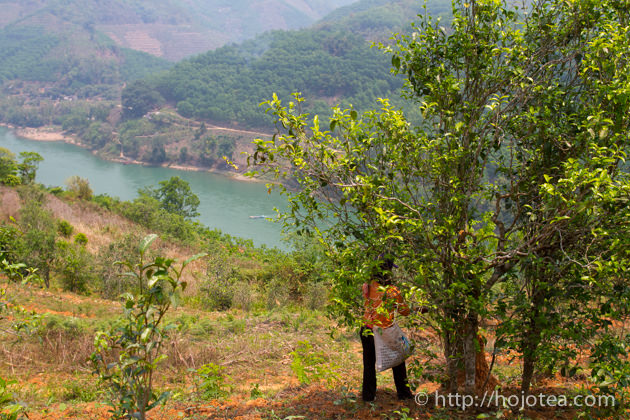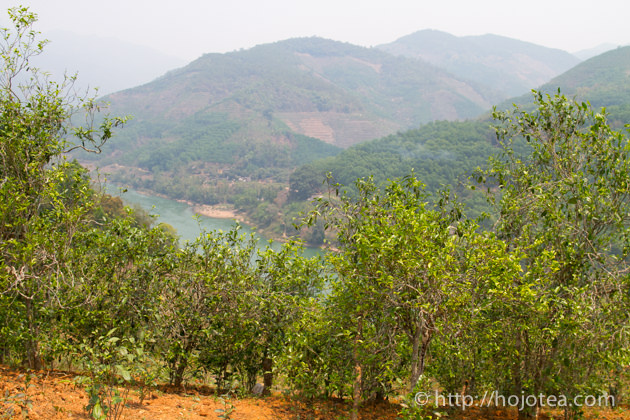- HOME >
- Origin of Tea
Xi Gui, the renowned pu-erh tea of south west Yunnan
- [2016.05.13] Posted By Akira Hojo

I believe the most famous production area of pu-erh tea should be Lao Ban Zhang, it is located at the south of Yunnan. In fact, there is another place called Xi Gui (昔帰) in the south west Yunnan. Xi Gui is highly renowned and the price is equally expensive as Lao Ban Zhang (老班章), yet it is not as famous as Lao Ban Zhang among the tea lovers in oversea. These two pu-erh teas should be often regarded the King and the Queen in pu-erh tea market.
Strong body
The common characteristics being observed among the famous pu-erh tea is the body. The taste of tea could widely spread in the palate and it gives very rich drinking sensation. However, I cherish and care about the aftertaste of tea when I evaluate tea. In China, the pu-erh tea produced from the old tea tree is booming up amount the collector. In fact, the older the age of tea tree it becomes, the stronger the after taste it is. Unfortunately not all people could sense and appreciate so-called aftertaste. Relatively more number of people could feel body on the contrary. This is the reason why always the tea with strong body preferred by more people and the fame of the tea is often in proportion to the intensity of the body. Because of this reason, I always regard body as the popularity and the aftertaste as the quality of the material.
Xi Gui developed along the Mekon River
Xi Gui is located in Lincang county, Lincang city, Yunnan. It is developed along the bank of Mekong River (called as Lincang Jiang in Chinese). The fertile soil brought by the Mekong River is very rich in calcium, and it seems to be contributing body.

The trend for frying very lightly in order to produce floral flavor
Recently the road condition to Xi Gui has been drastically improved. It takes less than 5 hours to reach Xi Gui by car from Lincang city center. Under the circumstances, there are increasing number of high-amateur and tourist from all over China and other countries. Generally, they are less experienced in evaluating the quality of tea. As a result, the tea that gives very floral scent is very popular. This kind of flavor can be easily produced if the manufacture lightly fry tea and retain more enzymes that develop floral scent like oolong during sunshine drying on account of enzymatic fermentation. However, the raw pu-erh tea produced with light pan-frying is not suitable for long storage. It develops sort of black tea flavor and noise in taste in a long run.

The river down there is the Mekong River
Changing the agricultural style
In a past 10 years, the price of Xi Gui has drastically increased. As the result of increasing demand, the more efforts are made so as to increase the productivity. Recently the tea gardens that practice natural farming in Xi Gui is noticeably decreasing. HOJO is not sourcing Xi Gui at the moment. The primary reason is its amazingly high price. In addition, we have Ma An Shan tea that gives equally strong body and very strong after taste, yet the price is lower.
Related Articles
How to get the latest update on HOJO?
1. Follow Twitter, 2. Click "Like" on Facebook, and 3. Subscribe in newsletter. You can have the latest tea news from HOJO.
 Subscribe the Newsletter to enjoy the privileges
Subscribe the Newsletter to enjoy the privileges- You may receive a free sample upon purchase, or you may have the priority to purchase special products. So please remember to subscribe our newsletter as well as the social network.
- 2024 Dong Shan Raw Pu-erh Tea – Crafted with the Producer for Desired Quality
- We have released the 2024 cake of Dong Shan Raw Pu-erh Tea. Earlier, we offered the loose-leaf version from th …
- New Arrival of Akitsu Mumyoi and Nosaka Rough Clay Teapot
- A wide selection of teaware by Watanabe Tozo, a Sado-based artist of Mumyoi-yaki, has just arrived. This time, …
NEW ARTICLES
 2024 Dong Shan Raw Pu-erh Tea – Crafted with the Producer for Desired Quality
2024 Dong Shan Raw Pu-erh Tea – Crafted with the Producer for Desired Quality- We have released the 2024 cake of Dong Shan Raw Pu-erh Tea. Earlier, we offered the loose-leaf version from th …
 Development of Firewood Roasted Hojicha Using Naturally Grown Tea from Yunnan
Development of Firewood Roasted Hojicha Using Naturally Grown Tea from Yunnan- We are currently staying in Yunnan Province for tea production. As the season nears its end, tea trees with pa …
 Exploring the Food Culture of Yunnan: Where Minority and Sichuan Cuisines Meet
Exploring the Food Culture of Yunnan: Where Minority and Sichuan Cuisines Meet- We are currently staying long-term in Yunnan Province for spring tea production. On rainy days or when there i …
 New Arrival of Akitsu Mumyoi and Nosaka Rough Clay Teapot
New Arrival of Akitsu Mumyoi and Nosaka Rough Clay Teapot- A wide selection of teaware by Watanabe Tozo, a Sado-based artist of Mumyoi-yaki, has just arrived. This time, …
 Managing Yunnan White Tea — Insights from the Field
Managing Yunnan White Tea — Insights from the Field- Since March 25, we have been in Yunnan Province, fully engaged in the production of white tea. In this column, …
 Mang Fei Ripe Pu-erh Tea 2023 – Small-Batch Production from a Renowned Region
Mang Fei Ripe Pu-erh Tea 2023 – Small-Batch Production from a Renowned Region- Mang Fei Ripe Pu-erh Tea 2023 is now available. This is one of the highest-quality ripe pu-erh teas among our …
 Yunnan Tea Trends 2025: Insights from the Fields
Yunnan Tea Trends 2025: Insights from the Fields- Since March 25, we have been in Yunnan Province. We will stay here until May to conduct tea production, packin …
 Why Do Some Teas Taste Astringent? Exploring the Causes and Mechanisms of Astringency
Why Do Some Teas Taste Astringent? Exploring the Causes and Mechanisms of Astringency- Tea can range from having no noticeable astringency to possessing a very strong one. What causes this astringe …
 The Impact of Heat Sources on Tea Flavor
The Impact of Heat Sources on Tea Flavor- It is widely recognized that the material of a kettle plays an important role in shaping the taste of water fo …
 New Release of Tang Li Shan Ripe Pu-erh Tea 2023
New Release of Tang Li Shan Ripe Pu-erh Tea 2023- We have released the 2023 edition of Tang Li Shan Ripe Pu-erh Tea. Tang Li Shan refers to a mountain located o …
Category
- New Arrival at HOJO Online Shop
- Featured Articles
- Newsletter
- Types of Tea
- Origin of Tea
- Teapot and Tea Equipment
- Tea Column
- How to enjoy tea
- Tea Processing
- How to choose quality tea
- Tea constituents and functional effect
- Safety of Tea
- Foods
- Tea Business Operation
- Hobby and Outdoor Activity
- Ranking of Tea
- Video
- FAQ
- Media Release
Profile

- AKIRA HOJO
- I invite you to experience my tea selections.I was born in Nagano, Japan. In university, I studied agricultural chemistry, and I have the master degree in food science. I worked in Japanese food industry for 10 years. I involved in R&D, QC and QA. As a factory manager, I implemented ISO9000 series and managed the factory.
- The Art of Tea Magazine
- We posted the article on “The Art of Tea Magazine No.9, the magazine is published in Taiwan. We featured …
- New Straits Times
- The Malaysian National Newspaper, New Straits Times featured HOJO Tea on 17-Oct-2007.
Shop Info

Address:Lot No. T-215, 3rd Floor, The Gardens Mall, Mid Valley City, Lingkaran Syed Putra, 59200 Kuala Lumpur
Tel: +603-2287-4537
Business Hour: 10am to 10pm















